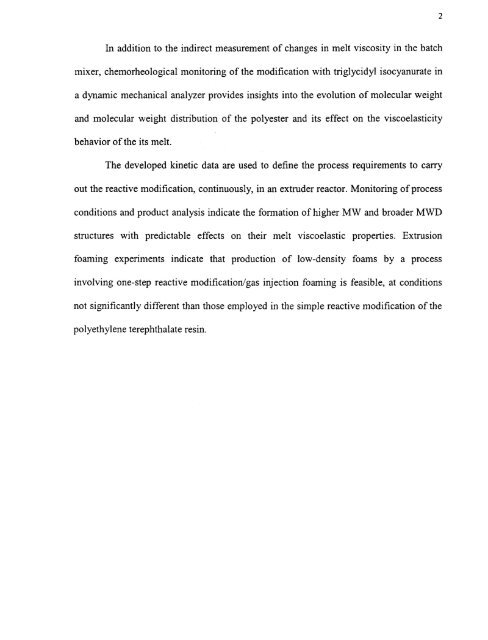- Page 1 and 2: Copyright Warning & Restrictions Th
- Page 3: ABSTRACT REACTIVE MELT MODIFICATION
- Page 7 and 8: BIOGRAPHICAL SKETCH Author: Rahul R
- Page 9 and 10: Copyright © 2003 by Rahul Ramesh D
- Page 11 and 12: ACKNOWLEDGEMENTS I always considere
- Page 13 and 14: TABLE OF CONTENTS Chapter Page 1 IN
- Page 15 and 16: TABLE OF CONTENTS (Continued) Chapt
- Page 17 and 18: LIST OF FIGURES Figure Page 1.1 Mac
- Page 19 and 20: LIST OF FIGURES (Continued) Figure
- Page 21 and 22: LIST OF FIGURES (Continued) Figure
- Page 23 and 24: Striation Thickness Time Diffusion
- Page 25 and 26: tertiary amine terephthalic acid th
- Page 27 and 28: CHAPTER 1 INTRODUCTION After its in
- Page 29 and 30: 3 of 0.5-1.00 mm Hg (Sorenson 2001)
- Page 31 and 32: where rib is the solution viscosity
- Page 33 and 34: 7 are not suitable for most of the
- Page 35 and 36: 9 In the case of sheet applications
- Page 37 and 38: 11 operation (Dealy and Wissbrun, 1
- Page 39 and 40: 13 During the cell growth phase of
- Page 41 and 42: 15 suitability of extruders as cont
- Page 43 and 44: 17 conditions and additive concentr
- Page 45 and 46: 19 understand the effect of evolvin
- Page 47 and 48: CHAPTER 3 LITERATURE REVIEW This ch
- Page 49 and 50: 23 absence of modifiers is accompan
- Page 51 and 52: 25 The primary objective while modi
- Page 53 and 54: 27 Polypropylene resins with high m
- Page 55 and 56:
29 initially the reaction with hydr
- Page 57 and 58:
31 A diglycidyl ether, often in the
- Page 59 and 60:
33 Characterizing the products of t
- Page 61 and 62:
35 5. Ease of mixing in the polymer
- Page 63 and 64:
37 Figure 3.4 Epoxy or 0xirane ring
- Page 65 and 66:
39 carbocation stability overrides
- Page 67 and 68:
41 Figure 3.9 Anhydride — epoxy r
- Page 69 and 70:
43 Figure 3.12 Base catalyzed hydro
- Page 71 and 72:
45 activity to enhance the PET-epox
- Page 73 and 74:
47 4.1.2 Chain EDtenders The struct
- Page 75 and 76:
TGDDM was used in the batch mixer s
- Page 77 and 78:
51 4.2 Processing and Characterizat
- Page 79 and 80:
53 specimens as a function of freVu
- Page 81 and 82:
55 to the parallel plates). An addi
- Page 83 and 84:
57 background spectrum. It took app
- Page 85 and 86:
CHAPTER 5 RESULTS AND DISCUSSION Th
- Page 87 and 88:
61 molecular weight of MPET as also
- Page 89 and 90:
63 rate expressions analogous to th
- Page 91 and 92:
Figure 5.5 Possible reactions betwe
- Page 93 and 94:
67 taking place by the convective;
- Page 95 and 96:
69 5.1.4 Comparison of Epoxides Fig
- Page 97 and 98:
71 5.1.5 Reactions of TGIC with HPE
- Page 99 and 100:
73 Figure 5.11 shows the vanation o
- Page 101 and 102:
75 Figure 5.13 shows the effect of
- Page 103 and 104:
77 to time. In a general sense, the
- Page 105 and 106:
79 5.1.7 Study on Role of Catalysts
- Page 107 and 108:
81 groups adjacent to the tertiary
- Page 109 and 110:
83 overall less activity towards TG
- Page 111 and 112:
85 5.2.1 Typical Batch MiDing Runs
- Page 113 and 114:
87 It appears that the higher proce
- Page 115 and 116:
89 injection (Dealy and Wissbrun, 1
- Page 117 and 118:
91 rheological power scaling law fo
- Page 119 and 120:
93 In the calculations, the freVuen
- Page 121 and 122:
95 whereas H(?.) of the unmodified
- Page 123 and 124:
97 However, the disintegration of t
- Page 125 and 126:
99 the Section 4.1.3. As evident fr
- Page 127 and 128:
101 changes in dynamic moduli and m
- Page 129 and 130:
103 In the case of 270 °C, the mod
- Page 131 and 132:
105 accessibility of unreacted grou
- Page 133 and 134:
107 believed to be charactenzed by
- Page 135 and 136:
109 increase in the melt elasticity
- Page 137 and 138:
111 In general, for crosslinked sys
- Page 139 and 140:
113 crosslinked gels in swelling eV
- Page 141 and 142:
115 formation of epoxy/PET reaction
- Page 143 and 144:
117 A seVuential reactive extrusion
- Page 145 and 146:
CHAPTER 6 CONCLUSIONS AND RECOMMEND
- Page 147 and 148:
121 of PET by the selected tnepoxid
- Page 149 and 150:
REFERENCES S. Abe and M. Yamaguchi,
- Page 151 and 152:
125 L. M. Dossin and W. W. Graessle
- Page 153 and 154:
127 P. Huang, Z. Zhong, S. Zheng, W
- Page 155 and 156:
129 J. Meissner and J. Hostettler,
- Page 157 and 158:
131 T. Shiwaku, K. Hijikata, K. Fur
- Page 159 and 160:
133 M. Xanthos and S. K. Dey, "Foam

















